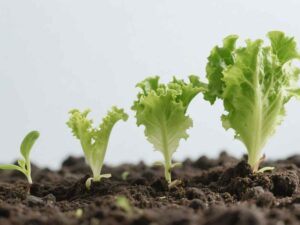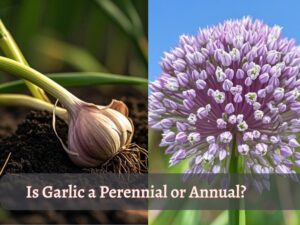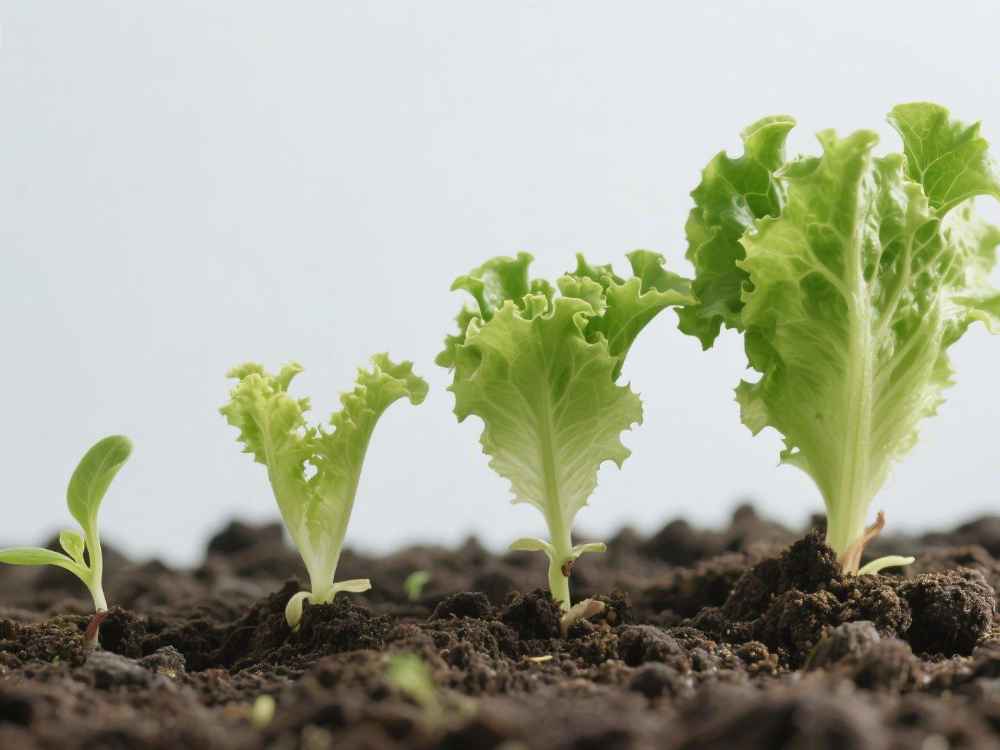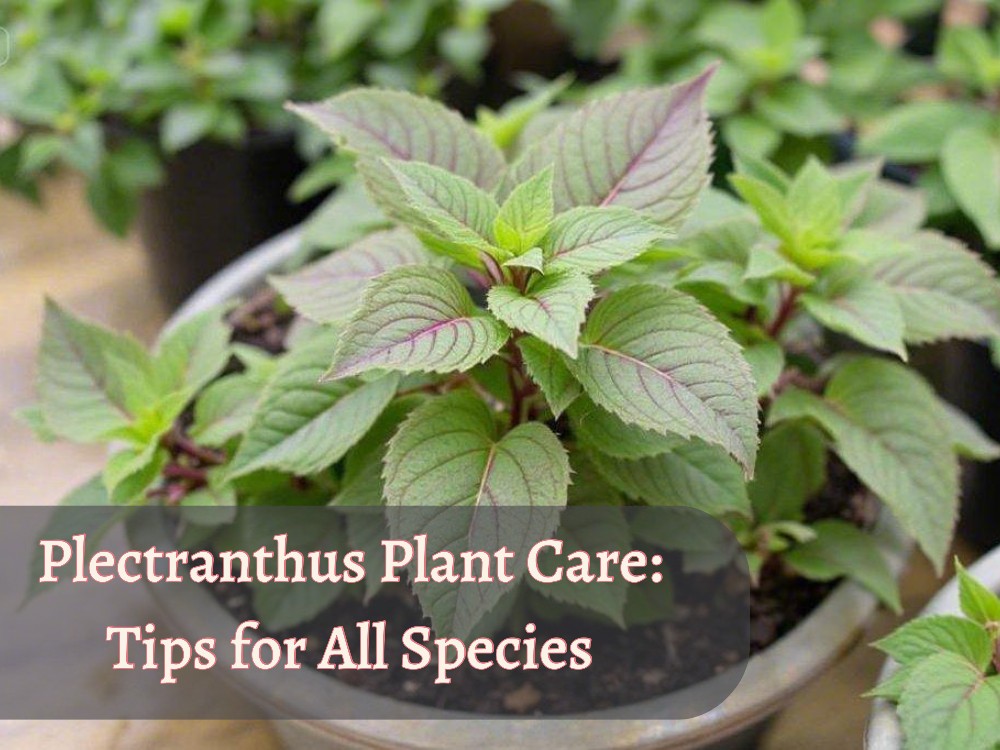Apparently, lettuce is considered an early-matured crop, but the hidden stages of lettuce growth are often overlooked.
Before growing lettuce, if this concept is not recognized at the right time, the lettuce either loses its leaves prematurely or enters a phase where its nutritional quality and market value are decreased. Apart from that, we also have an idea about best planting tiime for lettuce according to our climate.
Lettuce growth stages are not simple; rather, they are a level-by-level biological order in which each stage requires a specific environment, temperature, and light intensity.
That makes it important to understand the growth stages of lettuce with a scientific overview. It is not just educational practice but also a practical key to increasing yield.
If each growth stage is handled according to its biological requirements, this simple plant can yield much better leaf quality, higher harvesting frequency, and flavor intensity.
Lettuce Lifecycle: It is Annual, Biennial or Perennial
8 Key Growth Stages of Lettuce
The growth stages of any plant are genetically programmed, but these genetics can not be activated without environmental factors.
That’s why all environmental factors, including temperature, sunlight, water, air, humidity, and soil, affect them positively or negatively, depending on the care and maintenance. (here’s how)
So, let’s find out eight key growth stages of lettuce and their biological and environmental requirements with their ideal growing conditions;
Stage ❶: Seed Dormancy
As any plant’s growth starts from seed, regarding the lettuce growth stage, you have your own seeds at home, or you are going to buy them from the nursery.
This phase is called the seed stage, which apparently seems silent and quiet. But actually, it is the foundation through which the whole lettuce plant moves to other growth stages.
Do you know? Seeds germinate under moist and warm conditions, even without any interference. But this mostly happens in specific conditions when the seed naturally gets ideal conditions.
Lettuce seeds are different in color, size, and shape, depending on the variety. However, some initial signs of their viability include;
- Completely hard, it does not break easily when pressed.
- Uniformity in seeds (such as black, brown, or white, which is a varietal difference).
Research shows that black lettuce seeds are not only filled with flavonoids but also have a better capacity to germinate under temperature, meaning that the color of the seed coat is a critical hint of germination and viability.
Stage ❷: Seed Germination
Lettuce seed germination is the biological transition in which seed dormancy activates in a specific environment. For fast germination:
- The temperature of the soil or growing medium should be 15 to 22 Celsius.
- Apart from that, the medium also should be moist but not waterlogged. Here is how it should be!
Lettuce seeds absorb water and swell through ambition, cracking the seed coat.
The real beginning of germination is the emergence of the initial part of the root, called the radicle.
According to a research standard, reaching radicle protrusion at 2 mm or 3 mm radicle length is the main sign of germination completion. Stage 2 is ended when the radicle reaches ≥2–3mm, and cotyledons come on the surface.
Generally, lettuce may take 5 to 10 days to germinate, but this rhythm completely depends on moisture, temperature, and seed quality.
For example, radicle fusion appears in basil or lettuce seeds in about days at an ambient 20 Celcius, while in cold (5 Celsius), it may take 10 days or even 15 days.
Light and Oxygen Role in Seed Germination: Although seeds can germinate in darkness, light surface exposure boosts germination. Additionally, aerobic respiration also improves in the oxygen-rich medium.
Stage ❸: Seedling Emergence
This stage takes about 6 to 10 days, along with the germination process. But even though the timing overlaps, lettuce seedling emergence is a separate stage in scientific terms because it begins above the ground and:
- Seedling emergence starts when the shoot (plumule) breaks through the soil surface.
- Cotyledons, the seed’s first leaves, become visible and begin photosynthesis.
- The seedling stands upright with its cotyledons fully opened.
- It is the first time the young lettuce plant interacts with light and air, marking its shift from underground development to above-ground growth.
Although seedling emergence occurs soon after germination begins, scientists treat it as a distinct growth phase of lettuce.
Seed germination is about internal activation under the soil, while emergence is about visible growth above it.
Stage ❹: True Leaf Formation
Once lettuce seedlings emerge, after 10 to 15 days, the cotyledons begin photosynthesis, where lettuce plants start to rely on light and their own food production for further growth.
As soon as the cotyledons of a lettuce seedling emerge above the soil, they begin the process of photosynthesis, provided the environment is ideal.
These seed leaves support the seedling briefly until true leaves begin to form, which shows the plant’s transition into the vegetative stage.
- True leaves typically start to appear 3 to 5 days after seedling emergence.
- The full formation of true leaves usually occurs within 10 to 15 days.
- In leaf varieties, such as red and oak leaf lettuce, true leaves are generally well-developed by day 10.
- This stage may take around 12 to 18 days in head lettuce varieties like icebergs
- Lettuce varieties and growing conditions affect the speed of this development.
Thus, the timing of true leaf development varies by variety, but it is a reliable indicator of the lettuce plant’s health and growth potential.
Do you know? As soon as those first tiny leaves pop out of the soil (cotyledons), the seedling stage begins, but it doesn’t end until the real “true leaves” start growing. So technically, the seedling stage is a combo of two important early growth phases!
Stage ❺: Vegetative Growth
As soon as the first or second true leaf appears after the cotyledons, the plant starts making its food through photosynthesis, using light.
At this time, the lettuce plant only focuses on producing vegetative parts (leaves, stems, roots).
That continued development of true leaves defines vegetative growth as more as leaves grow, the lettuce plant enters the vegetative phase. And this stage is practically divided into two parts;
- Early vegetative growth: when baby leaves appear once they reach about 3 to 4 inches. At this stage, we mostly harvest baby lettuce, especially for salads.
- Mature vegetative growth: when the leaves grow larger, usually around 5 to 6 inches, and become suitable for full harvest. It is the stage when lettuce is harvested for commercial use, as the leaves are now fully developed and ready to eat.
Leaf-type lettuce doesn’t form a head but still completes its life cycle with bolting and flowering. In contrast, head-type lettuce forms a compact head before moving to the flowering stage.
Stage ❻: Head Formation
After completing the earlier stages, seed stage, germination, seedling emergence, true leaf formation, and vegetative growth, lettuce plants, especially head-type varieties, enter a key phase called head formation.
This stage is the foundation of the crop’s commercial value, particularly in varieties like iceberg and butterhead, where a dense, central head is the primary harvest goal.
During this phase, the inner leaves curl inward and overlap, slowly forming a compact, rounded structure known as the “head.”
The energy created through earlier photosynthesis is now directed toward building the head rather than expanding new leaves.
Cool and stable temperatures are essential for proper head formation in head-type lettuce. Otherwise, the plant may bolt early and skip forming a head. But even in leaf-type lettuce, where no head forms, a cool environment is just as important. It helps the plant stay in vegetative growth longer and allows for continuous harvesting of tender baby leaves.
Whether a lettuce variety forms a head or not, environmental control plays a key role in avoiding premature bolting and in ensuring healthy, marketable leaves.
Stage ❼:Bolting
In lettuce, bolting indicates the transition from vegetative to reproductive growth. It typically begins when the plant elongates and produces a flowering stalk. This shift can be triggered by:
- High temperatures
- Long daylight hours
- Drought or environmental stress
Lettuce bolting is both a natural phase and a response to environmental cues. In commercial cultivation, growers try to prevent bolting to preserve the flavor and texture of the lettuce leaves.
However, when the goal is seed production, bolting and flowering are allowed to proceed naturally.
Do you know? Lettuce bolts even in perfect care because it’s an annual. No matter how ideal the conditions are, it’s wired to grow, flower, and end its life cycle. Stress just makes it happen faster!
Stage ❽: Flowring and Seeds Production
When a lettuce plant bolts, it gives a natural signal that it’s preparing to enter its reproductive phase, the flowering stage.
- After bolting, a long flowering stem starts to emerge from the center of the plant.
- Small buds appear on the top portion of this stem.
- These buds open into small, pale yellow flowers after a few days.
- Lettuce flowers are typically self-pollinating, though some cross-pollination may occur via wind or insects.
- Following pollination, each flower develops into a seed head.
- The seeds mature within 2 to 3 weeks and are ready for harvest once the flower dries and turns brown.
Flowering is rarely allowed in commercial lettuce production since it impacts leaf quality and taste. However, it is necessary when seed saving is the goal.
How Long Do Lettuce Growth Stages Take in a Complete Plant Life Cycle?
The complete growth cycle of lettuce, from seed to seed, is usually completed within one season.
- Leafy varieties often mature and flower faster, sometimes in just 60 to 70 days.
- Head-forming varieties take longer, typically 80 to 100 days, as head formation precedes flowering.
- These durations can vary based on variety, climate, light, and other environmental conditions.
In general, lettuce is considered a fast-maturing crop, with its entire life cycle, from seed germination to seed production, completing in 2 to 3 months, depending on its type and growing conditions.
Recomanded
- 8 Lettuce Growth Stages: A Deep Breakdown With Science

- Is Lettuce Annual, Biennial, or Perennial? Full Life Cycle

- Are Tomato Plants Annual or Perennial? Truth Has Been Revealed

- Is Garlic a Perennial or Annual? Why Leaving It in Soil Matters

- How Long Does Garlic Take to Grow Naturally?

- When Do Biennials Complete Their Life Cycle? Discover the Truth







